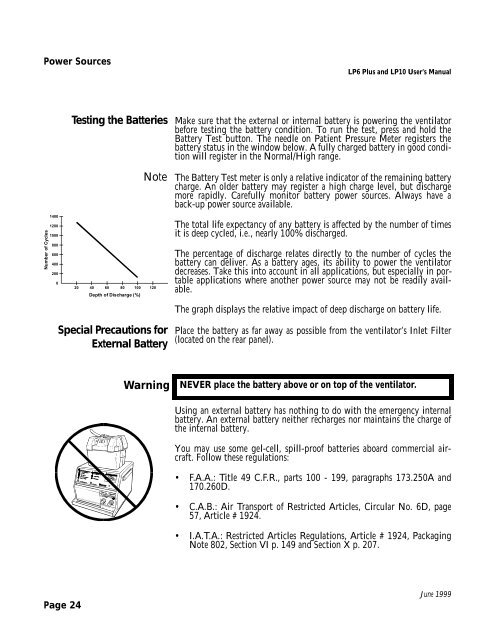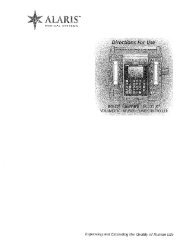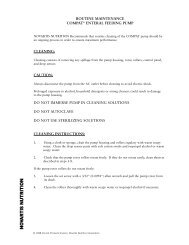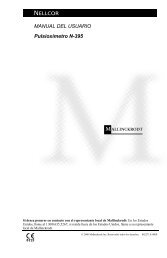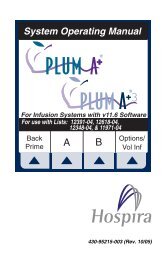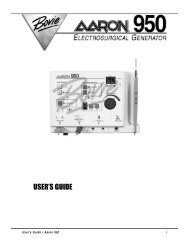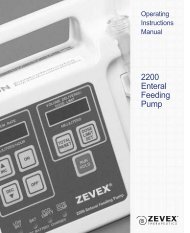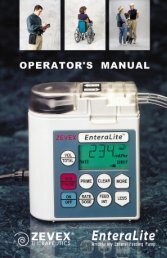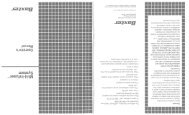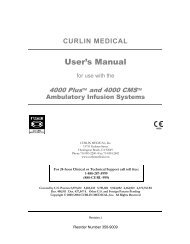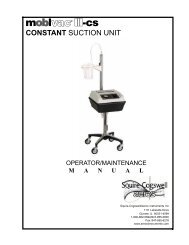LP6 Plus Volume Ventilator -And- LP10 Volume Ventilator With ...
LP6 Plus Volume Ventilator -And- LP10 Volume Ventilator With ...
LP6 Plus Volume Ventilator -And- LP10 Volume Ventilator With ...
You also want an ePaper? Increase the reach of your titles
YUMPU automatically turns print PDFs into web optimized ePapers that Google loves.
Power Sources<br />
Number of Cycles<br />
1400<br />
1200<br />
1000<br />
800<br />
600<br />
400<br />
200<br />
0<br />
Page 24<br />
<strong>LP6</strong> <strong>Plus</strong> and <strong>LP10</strong> User’s Manual<br />
Testing the Batteries Make sure that the external or internal battery is powering the ventilator<br />
before testing the battery condition. To run the test, press and hold the<br />
Battery Test button. The needle on Patient Pressure Meter registers the<br />
battery status in the window below. A fully charged battery in good condition<br />
will register in the Normal/High range.<br />
20 40 60 80 100 120<br />
Depth of Discharge (%)<br />
Special Precautions for<br />
External Battery<br />
Note The Battery Test meter is only a relative indicator of the remaining battery<br />
charge. An older battery may register a high charge level, but discharge<br />
more rapidly. Carefully monitor battery power sources. Always have a<br />
back-up power source available.<br />
The total life expectancy of any battery is affected by the number of times<br />
it is deep cycled, i.e., nearly 100% discharged.<br />
The percentage of discharge relates directly to the number of cycles the<br />
battery can deliver. As a battery ages, its ability to power the ventilator<br />
decreases. Take this into account in all applications, but especially in portable<br />
applications where another power source may not be readily available.<br />
The graph displays the relative impact of deep discharge on battery life.<br />
Place the battery as far away as possible from the ventilator’s Inlet Filter<br />
(located on the rear panel).<br />
Warning NEVER place the battery above or on top of the ventilator.<br />
Using an external battery has nothing to do with the emergency internal<br />
battery. An external battery neither recharges nor maintains the charge of<br />
the internal battery.<br />
You may use some gel-cell, spill-proof batteries aboard commercial aircraft.<br />
Follow these regulations:<br />
• F.A.A.: Title 49 C.F.R., parts 100 - 199, paragraphs 173.250A and<br />
170.260D.<br />
• C.A.B.: Air Transport of Restricted Articles, Circular No. 6D, page<br />
57, Article # 1924.<br />
• I.A.T.A.: Restricted Articles Regulations, Article # 1924, Packaging<br />
Note 802, Section VI p. 149 and Section X p. 207.<br />
June 1999


